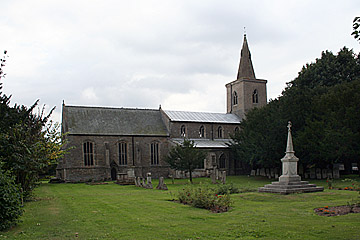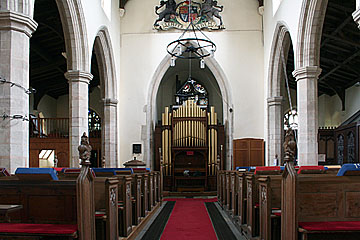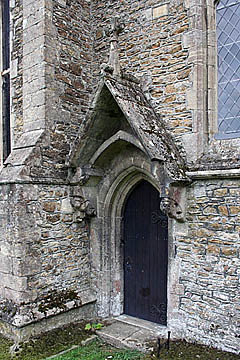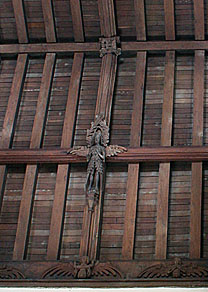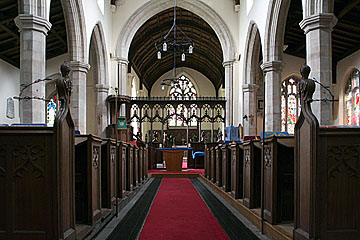Doddington is now something of a backwater, bypassed to the east by the busy A141 from Chatteris to March. Once upon a time, though, this was one of the principal centres of population in the Isle of Ely, sitting as it does on one of the few ridges in this part of the fens.
In 970, when the abbey at Ely was restored after having been destroyed by the Vikings a century earlier, Doddington was one of the manors with which the new foundation was endowed. It is mentioned at Domesday, and the bishops of Ely even had a palace here. (For the inhabitants, incidentally, this was more of a nuisance than anything else, since they were under an obligation, if ordered, to ferry the bishop to one of his neighbouring manors. Not too much of a bother if he wanted to go to Downham, which is about five miles to the south-east, but really rather awkward if he wants to be taken the twelve or so miles down to Willingham).
The combination of a decent population and extreme isolation meant that the medieval parish of Doddington was one of the largest in England, covering nearly thirty-eight thousand acres. This included other little settlements on the same ridge, such as Benwick and March, and these were eventually separated off as distinct parishes in 1847, leaving Doddington itself with a much shrunken territory.
All of this implies that there must have been a Saxon church in Doddington, once upon a time. What we see now though is rather younger. The oldest parts of the church were started in the middle of the 13th century: part of the north aisle dates from then, as does the basic structure of the chancel. About a hundred years later there was a big reconstruction in which the nave arcades, the tower, the south aisle and the western end of the north aisle were built. The fifteenth century added a south porch, and fitted out the chancel with some very nice tall three-light Perpendicular windows.
From the outside, this pleasing spread of periods makes St Mary look rather promising. The tower has a sweet little stumpy spire, and is clasped by the aisles on its north and south faces. The windows are all a bit uniform (though the chancel windows did look quite exciting), but we found an interest canopy over the priest’s door: a small steeply pitched stone gable, held up by corbels carved into interesting shapes, including a fine monkey.
Sadly, the interior fails to live up to expectations, and the church reeks of its 19th century restorers when one first steps inside. Or, rather, it doesn’t, because just inside the north door there is a peculiar little glass enclosure like an octagonal greenhouse enclosing the entrance. The structure seems to serve as a frame for some panels of Victorian stained glass rescued from Benwick church before it was knocked down in 1983, so I suppose I ought not to be too nasty, but really! It looks stupid and it must be a dashed nuisance whenever a lot of people are trying to enter or leave the church. The glass isn’t even very nice.
So, strictly speaking I should have said that the church reeks of the 19th century - when one has passed the airlock. It is terribly murky, due to the extremely dark glass in the windows, and the small nave (of four bays) is filled with pews. The modern congregation has filled these with a colourful army of kneelers, which try (somewhat unsuccessfully) to mitigate the gloom.
To be slightly more positive, I liked the roof in the nave, which has angels everywhere on the wall-plates and the tie beams. There are even some big six-winged seraphim attached to the rafters. Everything I’ve read about the church is a big ambiguous about this roof – the most the guidebook says is that there was an ‘extensive restoration’ in 1892 – but I’m almost certain that the angels are Victorian. Still, they’re fine thing, even if they could use a bit of paint to make them more visible in the darkness.
The chancel roof is also Victorian, and they decided to go for high Tudor style, with corbels that look like small inverted versions of the pinnacles of King’s College chapel. I tried to feel enthusiasm about the screen, which is just a little bit too regular to look properly medieval, and firmly refused to feel enthusiastic about the rebuilt east end.
In front of the altar, there is the tombstone of Sir John Peyton, one-time Governor of Jersey and Guernsey. The Peytons are more often associated with Isleham, which was their principal seat and whose church contains many fine Peyton memorials. This was one of their secondary estates: the Manor of Doddington, which had presumably been appropriated by the crown in the Dissolution, was given to Sir John by Queen Elizabeth in 1601, presumably as a sign of favour for having managed his office well. In the end, Sir John lived to the ripe age of 99, and was buried here rather than in the family chapel. Several of his descendents joined him, though none ever lived here, despite there having been a number of Peyton rectors in the 17 th and 19 th centuries.
The guidebook to St Mary is very good, and tells an interesting story about a member of the Peyton family. According to legend, one of them killed a servant, and the punishment was that the image of a bloody hand should be painted on all his possessions, including his pew in the church. I failed to find the hand, which is apparently at the end of a choir stall on the north side of the chancel, but the story caught my imagination and filled me with anger. It made me think of a Bob Dylan song:
In the courtroom of honour, the judge pounded his gavel
To show that all's equal and that the courts are on the level
And that the strings in the books ain't pulled and persuaded
And that even the nobles get properly handled
Once that the cops have chased after and caught 'em
And that the ladder of law has no top and no bottom,
Stared at the person who killed for no reason
Who just happened to be feelin' that way without warnin'.
And he spoke through his cloak, most deep and distinguished,
And handed out strongly, for penalty and repentance,
William Zantzinger with a six-month sentence.
St Mary is kept locked, but there are keyholders listed.
